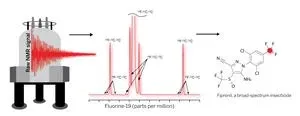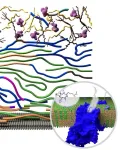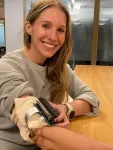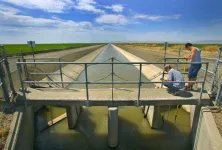(Press-News.org) Organofluorine compounds — sometimes called ‘forever chemicals’ — are increasingly turning up in our drinking water, oceans and even human blood, posing a potential threat to the environment and human health.
Now, researchers at The University of Texas at Austin have developed a way to fingerprint them, which could help authorities trace them to their source when they end up in aquifers, waterways or soil.
The technique involves passing samples through a strong magnetic field then reading the burst of radio waves their atoms emit. This reveals the composition of carbon isotopes in the molecule and gives the chemical its fingerprint, a feat that had not previously been achieved with forever chemicals.
The work is important because it allows scientists to track the spread of forever chemicals in the environment, said Cornelia Rasmussen, a research assistant professor at the University of Texas Institute for Geophysics at the Jackson School of Geosciences.
“Ultimately we will be able to trace molecules and see how they move,” said Rasmussen, who co-led development of the technique. “For example, whether they just stay where they got dumped or whether they’re moving downstream.”
The new technique was described in a paper published in the journal Environmental Science & Technology.
The super strong molecular bonds that give forever chemicals their handy characteristics — which are put to use in everything from fire retardants to non-stick surfaces and slow-release drugs — also keep them from breaking down in the environment, causing them to build up as pollution in soil and organic material to which they easily stick
The U.S. Environmental Protection Agency plans to regulate forever chemicals, which include PFAS, and eliminate most of them from drinking water. However, the molecular bonds of the chemicals also make them difficult to trace. That’s because conventional chemical fingerprinting involves breaking molecules apart in a mass spectrometer which doesn’t work well with the tough molecular bonds of forever chemicals.
Instead, the researchers turned to a technology called nuclear magnetic resonance (NMR) spectroscopy, which measures a molecule’s structure and identifies its isotopes without breaking it apart.
Isotopes refer to chemical elements with differences in the number of neutrons in its atoms. Forever chemicals are made by bonding carbon isotopes to the element fluorine, which almost never happens in nature. Once the molecular bonds form, they are virtually unbreakable.
The researchers’ technique uses the NMR instrument alongside their own computational tools to determine the mix of carbon isotopes at each position in the molecule. Because the mix of carbon isotopes bonding to each fluorine atom is unique to how the chemical was manufactured, this information can be used like a fingerprint to trace a chemical.
It’s like a built-in barcode for molecules, said coauthor, David Hoffman, an associate professor at the Department of Molecular Biosciences in UT’s College of Natural Sciences.
“Part of the reason this has worked out so well is because we’re assembling tools from different areas of science [chemistry and geosciences] that don’t normally mix and using them to do something no one’s really done before,” he said.
The researchers tested their technique on samples that included pharmaceuticals and a common pesticide. Rasmussen and Hoffman are now conducting a pilot study to see how the technique will fare on pollutants that show up in the city of Austin’s creeks and wastewater. If successful, the technique could be useful for state and federal agencies who want to track the spread of water-borne forever chemicals.
Rasmussen said that the work has opened up a new layer of isotope information in organic chemistry that could find many applications beyond tracking forever chemicals, such as detecting counterfeit drugs or astrobiology. Her ultimate goal, however, is to take the technique even further afield.
“It’s given us a whole range of possibilities to learn really interesting things about metabolism on early Earth,” she said. “It could even tell us whether organics on Mars are the last remnants of some ancient Martian life.”
The research was funded by the U.S. Department of Energy’s Basic Energy Sciences program.
END
Forever chemical pollution can now be tracked
2024-08-07
ELSE PRESS RELEASES FROM THIS DATE:
How fungi elude antifungal treatments
2024-08-07
Every year, life-threating invasive fungal infections afflict more than 2 million individuals globally. Mortality rates for these infections are high, even when patients receive treatment.
Aspergillus fumigatus, the most frequent cause of invasive fungal infection in people with suppressed immune systems, is responsible for approximately 100,000 deaths annually around the world. Poor treatment outcomes result from therapeutic failures and the fungi’s resistance to existing drugs.
A new multi-institutional study led by researchers at Michigan State University has characterized how fungi adapt to restructure their cell walls, effectively ...
ACC Asia 2024 explores emerging trends, evidence-based strategies for improving global heart health
2024-08-07
The American College of Cardiology (ACC) and the Cardiological Society of India will host ACC Asia 2024 on August 16-18 in Delhi, India. This conference will bring together all members of the cardiac care team to examine emerging trends and best practices for cardiovascular disease patient care.
“One of the most meaningful outcomes of the annual ACC Asia conference is the ability to communicate with other cardiologists to strategize and innovate new ideas,” said Eugene Yang, MD, MS, FACC, one of the ACC Asia conference co-chairs. “As ...
CalTech team develops first noninvasive method to continually measure true blood pressure
2024-08-07
Solving a decades-old problem, a multidisciplinary team of Caltech researchers has figured out a method to noninvasively and continually measure blood pressure anywhere on the body with next to no disruption to the patient. A device based on the new technique holds the promise to enable better vital-sign monitoring at home, in hospitals, and possibly even in remote locations where resources are limited.
The new patented technique, called resonance sonomanometry, uses sound waves to gently stimulate resonance ...
Using photos or videos, these AI systems can conjure simulations that train robots to function in physical spaces
2024-08-07
Researchers working on large artificial intelligence models like ChatGPT have vast swaths of internet text, photos and videos to train systems. But roboticists training physical machines face barriers: Robot data is expensive, and because there aren’t fleets of robots roaming the world at large, there simply isn’t enough data easily available to make them perform well in dynamic environments, such as people’s homes.
Some researchers have turned to simulations to train robots. Yet even that process, which often involves a graphic designer ...
When is too much knowledge a bad thing?
2024-08-07
CORNELL UNIVERSITY MEDIA RELATIONS OFFICE
FOR RELEASE: August 7, 2024
Kaitlyn Serrao
607-882-1140
kms465@cornell.edu
When is too much knowledge a bad thing?
ITHACA, N.Y. – A new study finds an increase in knowledge could be a bad thing when people use it to act in their own self-interest rather than in the best interests of the larger group.
Cornell University economics professor Kaushik Basu and Jörgen Weibull, professor emeritus at the Stockholm School of Economics, are co-authors ...
Do smells prime our gut to fight off infection?
2024-08-07
Many organisms react to the smell of deadly pathogens by reflexively avoiding them. But a recent study from the University of California, Berkeley, shows that the nematode C. elegans also reacts to the odor of pathogenic bacteria by preparing its intestinal cells to withstand a potential onslaught.
As with humans, nematodes’ guts are a common target of disease-causing bacteria. The nematode reacts by destroying iron-containing organelles called mitochondria, which produce a cell's energy, to protect this critical element from iron-stealing bacteria. Iron is a key catalyst in many enzymatic reactions in cells — in particular, ...
mTORC1 in classical monocytes: Links to human size variation & neuropsychiatric disease
2024-08-07
"This report suggests that a simple assay may allow cost-effective prediction of medication response."
BUFFALO, NY- August 7, 2024 – A new research paper was published in Aging (listed by MEDLINE/PubMed as "Aging (Albany NY)" and "Aging-US" by Web of Science), Volume 16, Issue 14 on July 26, 2024, entitled, “mTORC1 activation in presumed classical monocytes: observed correlation with human size variation and neuropsychiatric disease.”
In this new study, researchers Karl Berner, Naci Oz, Alaattin Kaya, Animesh Acharjee, and Jon Berner ...
In Parkinson’s, dementia may occur less often, or later, than thought
2024-08-07
MINNEAPOLIS – There’s some good news for people with Parkinson’s disease: The risk of developing dementia may be lower than previously thought, or dementia may occur later in the course of the disease than previously reported, according to a study published in the August 7, 2024, online issue of Neurology®, the medical journal of the American Academy of Neurology.
“The development of dementia is feared by people with Parkinson’s, and the combination of both a movement disorder and a cognitive disorder can be devastating to them and their loved ones,” said study author Daniel Weintraub, MD, ...
Impact of drought on drinking water contamination: disparities affecting Latino/a communities
2024-08-07
Long-term exposure to contaminants such as arsenic and nitrate in water is linked to an increased risk of various diseases, including cancers, cardiovascular diseases, developmental disorders and birth defects in infants. In the United States, there is a striking disparity in exposure to contaminants in tap water provided by community water systems (CWSs), with historically marginalized communities at greater risks compared to other populations. Often, CWSs that distribute water with higher contamination levels exist in areas that lack adequate public infrastructure or sociopolitical and financial resources.
In ...
Pesticide exposure linked to stillbirth risk in new study
2024-08-07
Living less than about one-third of a mile from pesticide use prior to conception and during early pregnancy could increase the risk of stillbirths, according to new research led by researchers at the Mel and Enid Zuckerman College of Public Health and Southwest Environmental Health Sciences Center.
Researchers found that during a 90-day pre-conception window and the first trimester of pregnancy, select pesticides, including organophosphates as a class, were associated with stillbirth.
The paper, “Pre-Conception ...







